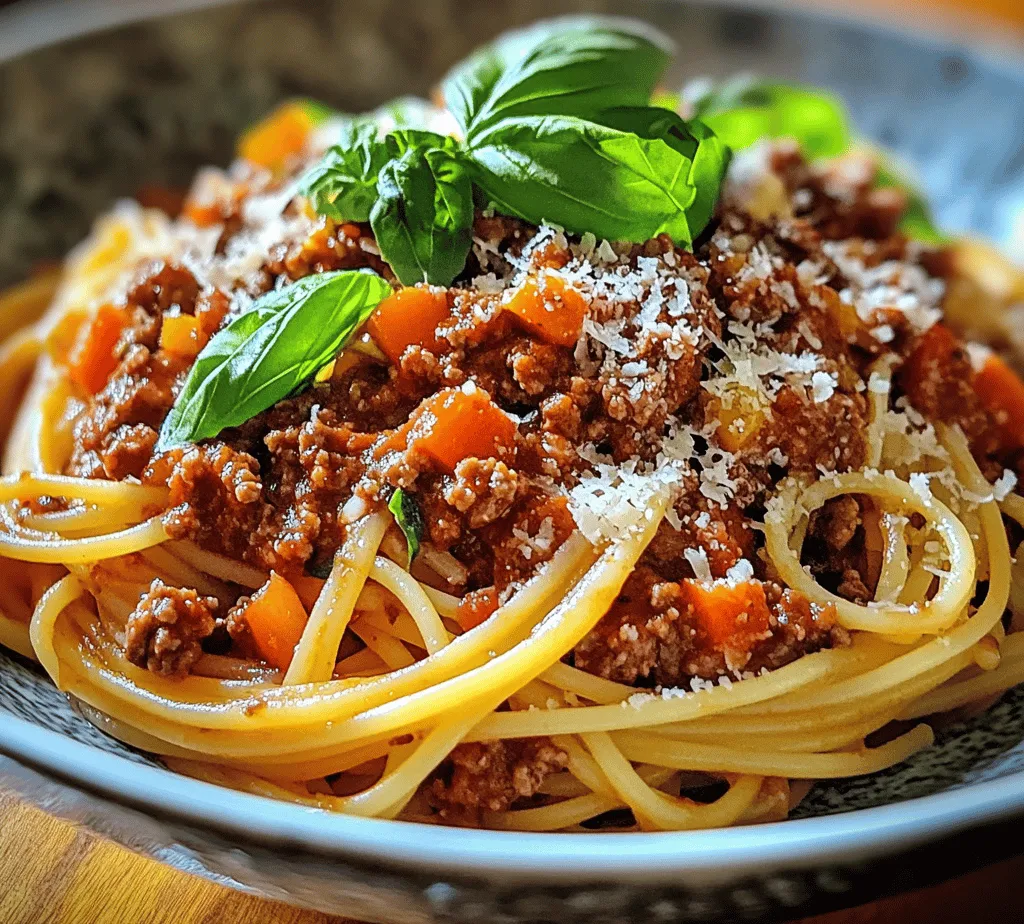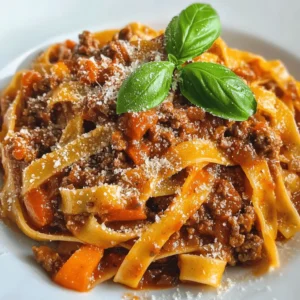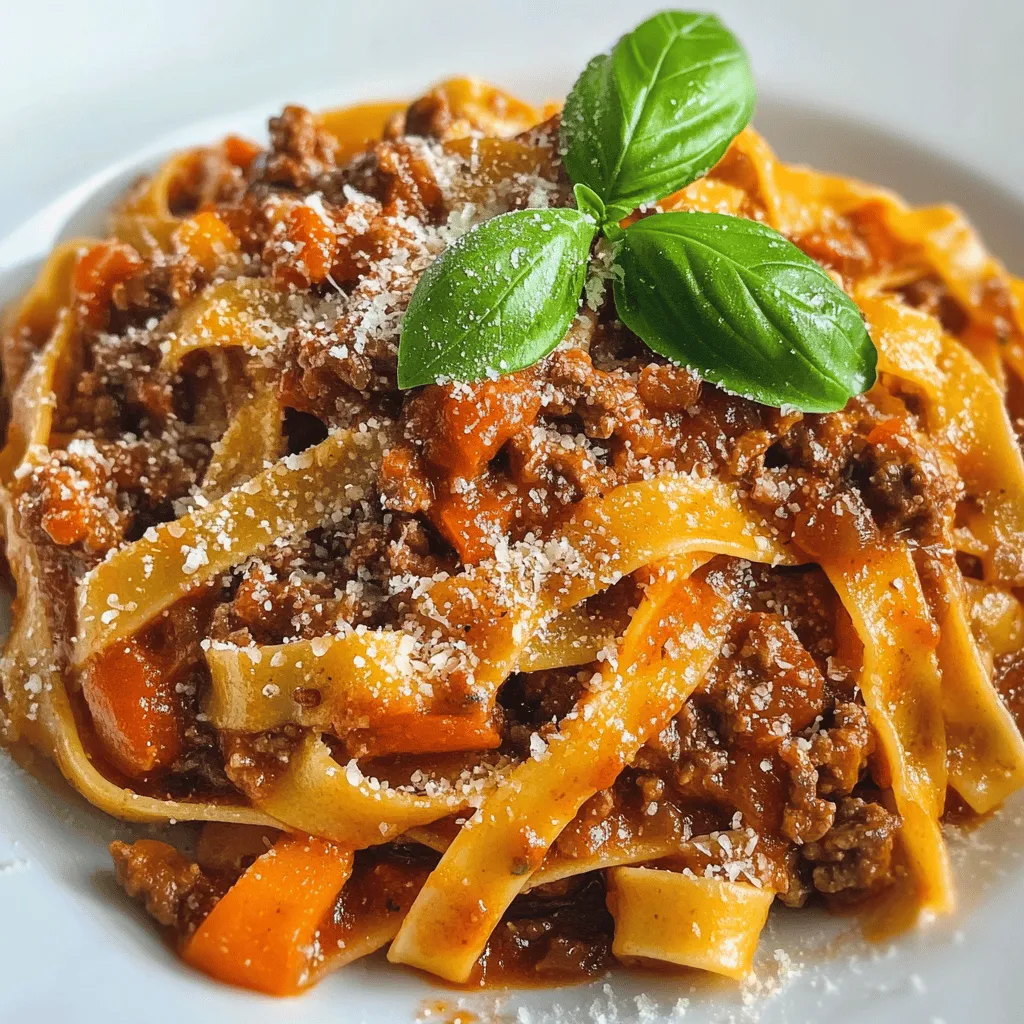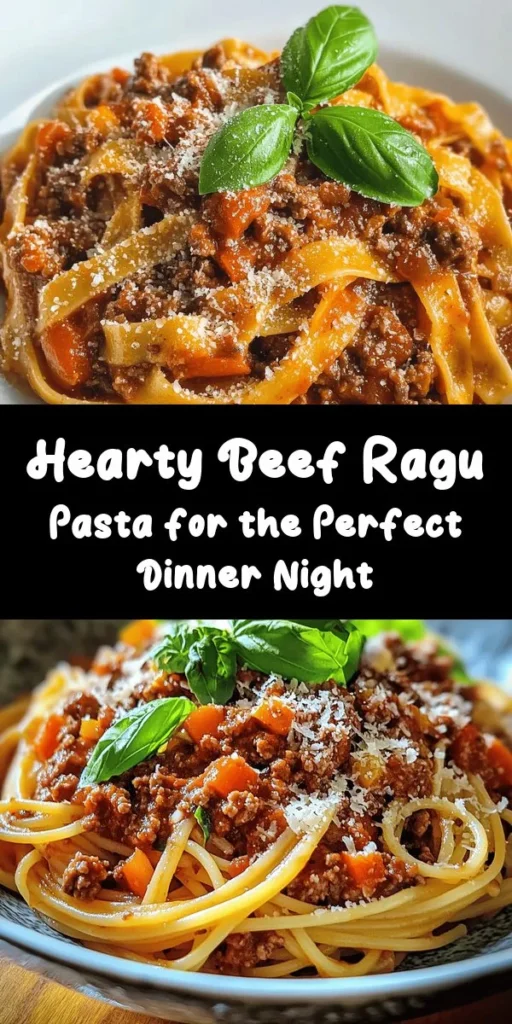Beef Ragu Pasta is a classic Italian dish that embodies the essence of comfort food, bringing together the rich flavors of slow-cooked beef and hearty pasta. This dish is not only a staple in Italian households but also a favorite among culinary enthusiasts around the world. Its allure lies in the depth of flavor achieved through a slow cooking process, which allows the ingredients to meld together beautifully. In this article, we will explore the ingredients, cooking techniques, and the cultural significance of Beef Ragu Pasta, ensuring that you not only follow the recipe but also appreciate the roots and traditions of this beloved dish.
Understanding Beef Ragu: A Culinary Tradition
The Origins of Ragu
Ragu has a storied history within Italian cuisine, tracing back to the 18th century. It is believed that the term “ragu” comes from the French word “ragout,” which means to stew. This connection highlights the influence of French culinary techniques on Italian cooking, particularly in the northern regions of Italy. Traditionally, ragu was a way to transform tougher cuts of meat into tender, flavorful dishes through slow cooking.
Regional variations of ragu are abundant in Italy, each showcasing unique characteristics that reflect local ingredients and culinary traditions. For instance, the famous Bolognese ragu, originating from Bologna, is characterized by its use of minced meat, tomatoes, and a variety of vegetables, simmered for hours to create a rich sauce. In contrast, Neapolitan ragu often incorporates larger cuts of meat, such as beef or pork, and is simmered with tomatoes and aromatic herbs, resulting in a heartier dish that is served alongside pasta.
What Makes Beef Ragu Unique
What sets Beef Ragu apart from other pasta sauces is the emphasis on slow cooking, which is pivotal in developing complex flavors. While many sauces can be prepared in a matter of minutes, ragu requires patience and time. This slow simmering allows the beef to become tender and absorb the flavors of the accompanying ingredients, resulting in a deeply satisfying sauce that clings beautifully to pasta.
When comparing Beef Ragu to other pasta sauces, such as marinara or Alfredo, the differences are striking. Marinara is typically a quick sauce made with fresh tomatoes, garlic, and herbs, while Alfredo relies on cream and cheese for its richness. In contrast, Beef Ragu is robust and savory, with a depth of flavor that is achieved through a carefully curated blend of ingredients and a slow cooking process. This makes it an ideal choice for family meals or special occasions, where the goal is to create a comforting dish that feels both indulgent and satisfying.
Ingredients Breakdown: What You Need for the Perfect Beef Ragu Pasta
To create a delicious Beef Ragu Pasta, it’s essential to choose high-quality ingredients that will enhance the overall flavor and texture of the dish. Below, we break down the key components that make this dish a standout.
Essential Ingredients
– Ground Beef: The star of the dish, ground beef provides the rich, meaty flavor that forms the base of the ragu. Opt for a blend with a bit of fat, such as 80/20, to ensure a juicy sauce.
– Pasta: While traditional recipes often call for tagliatelle or pappardelle, the choice of pasta can vary according to personal preference. The pasta should be hearty enough to hold up against the robust sauce.
– Vegetables: A classic mirepoix of onions, carrots, and celery is essential for building the flavor foundation of the ragu. These aromatic vegetables contribute sweetness and depth to the sauce.
– Garlic: Fresh garlic adds an aromatic punch that elevates the flavor profile of the dish, enhancing the overall richness.
– Tomatoes: Use high-quality canned tomatoes for the ragu, as they provide a rich, tangy base. San Marzano tomatoes are often recommended for their sweetness and low acidity.
– Herbs: Fresh or dried herbs such as thyme, bay leaves, and parsley bring an aromatic freshness to the sauce, balancing the richness of the beef.
– Red Wine: A splash of red wine not only adds acidity and depth but also helps to tenderize the meat during the cooking process.
– Stock or Broth: Beef stock or broth is essential for achieving the desired consistency of the sauce and enhancing the meaty flavor.
Substitutions and Variations
While the traditional Beef Ragu Pasta is delicious, there are several substitutions and variations to consider that can cater to different tastes and dietary preferences:
– Alternative Meats: If you’re looking to switch things up, ground pork or turkey can be used in place of beef. Each option will impart its unique flavor to the dish.
– Vegetarian Options: For a meat-free version, consider using mushrooms or lentils. Mushrooms provide a savory umami flavor, while lentils offer a hearty texture that mimics ground meat.
– Pasta Choices: While tagliatelle and pappardelle are traditional, you can also experiment with other pasta shapes like fettuccine, rigatoni, or even whole wheat options. Each pasta shape will offer a different eating experience, and some may hold the sauce better than others.
Step-by-Step Cooking Instructions for Beef Ragu Pasta
Now that we’ve covered the essential ingredients and their variations, let’s dive into the step-by-step instructions for preparing Beef Ragu Pasta, starting with the preparation of the pasta.
Preparing the Pasta
Cooking the pasta correctly is crucial for achieving the perfect Beef Ragu Pasta. Here are some tips to ensure your pasta is cooked to perfection:
1. Choose the Right Pasta: Select a pasta shape that complements the ragu. Wide noodles like tagliatelle or pappardelle work wonderfully, but feel free to use your favorite pasta.
2. Cook Al Dente: Bring a large pot of salted water to a boil, and add the pasta. Cook according to the package instructions until it is al dente—firm to the bite. This is important because the pasta will continue to cook slightly when combined with the ragu.
3. Reserve Pasta Water: Before draining the pasta, reserve about a cup of the cooking water. This starchy water can be added to the ragu later to adjust the sauce’s consistency, ensuring it clings beautifully to the pasta.
Sautéing the Vegetables
The next step involves sautéing the vegetables, which is a crucial part of building the flavor profile of your Beef Ragu.
1. Chop Your Vegetables: Finely dice the onions, carrots, and celery. The smaller the pieces, the better they will meld into the sauce, providing a consistent texture.
2. Heat the Oil: In a large, heavy-bottomed pot or Dutch oven, heat a few tablespoons of olive oil over medium heat. The oil will help to sauté the vegetables and add richness to the sauce.
3. Sauté Until Softened: Add the chopped onions, carrots, and celery to the pot, stirring frequently. Cook for about 5-7 minutes, or until the vegetables are softened and the onions are translucent. This step is crucial as it lays the foundation for the sauce’s flavor.
4. Add Garlic: Once the mirepoix is softened, add minced garlic to the pot and sauté for an additional minute until fragrant. Be careful not to burn the garlic, as it can turn bitter.
By following these initial steps, you’re already on your way to creating a flavorful and satisfying Beef Ragu Pasta. The combination of slow-cooked beef, aromatic vegetables, and the right choice of pasta will ensure that this dish becomes a cherished favorite in your kitchen. In the next sections, we’ll explore the process of combining these elements into a delicious sauce, as well as tips for serving and enjoying this classic Italian meal.

Browning the Beef
Browning the ground beef is a crucial step in developing the flavor profile of your Beef Ragu Pasta. Proper browning not only enhances the taste but also contributes to the dish’s overall texture. Here are some best practices to ensure you achieve that perfect sear:
1. Choose the Right Pan: A heavy-bottomed skillet or Dutch oven is ideal for even heat distribution. This helps in achieving uniform browning without burning.
2. Preheat the Pan: Before adding the beef, make sure the pan is hot enough. A hot pan allows the meat to sear rather than steam, which is essential for flavor development.
3. Avoid Overcrowding: Cook the beef in batches if necessary. Overcrowding the pan can lower the temperature, resulting in steamed meat rather than browned. Aim for a single layer of beef to maximize contact with the pan.
4. Seasoning: Season the beef with salt and pepper as it cooks. This not only adds flavor but helps to draw out moisture, aiding in the browning process.
5. Managing Excess Fat: After browning the beef, you may notice excess fat in the pan. For a healthier dish, carefully drain some of the fat, leaving enough to keep the dish moist and flavorful. Alternatively, you can choose leaner cuts of beef or even mix in ground turkey or chicken for a lighter option.
Crafting the Ragu Sauce
Once your beef is browned to perfection, it’s time to craft the ragu sauce. This is where the dish truly comes together, with tomatoes, herbs, and liquids working in harmony to create a rich, savory sauce.
1. Combining Tomatoes, Herbs, and Liquids: After browning the beef, you’ll want to add your tomatoes—be it crushed tomatoes, tomato paste, or diced tomatoes—alongside aromatics like garlic and onions. Fresh herbs like basil, oregano, and thyme elevate the flavor. A splash of red wine or broth adds depth; simmer for about 2-3 minutes to allow the alcohol to cook off, enhancing the sauce’s complexity.
2. Balancing Flavors: Taste your sauce as it simmers. Adjust acidity with a pinch of sugar if the tomatoes are overly tart. A dash of balsamic vinegar can also introduce a sweet and tangy note. Remember, balance is key; you want the flavors of the meat, tomatoes, and herbs to shine through.
3. The Simmering Process: Allow your sauce to simmer gently for at least 30 minutes, although longer is better. This slow cooking allows the flavors to meld, and the sauce thickens to a luxurious consistency. Stir occasionally to prevent sticking, and feel free to add a little water or broth if it thickens too much.
Mixing Pasta with Sauce
Once your sauce is ready, it’s time to bring it all together with the pasta. Proper mixing ensures that every strand of pasta is coated with the delicious ragu sauce.
1. Techniques for Even Coating: After cooking your pasta to al dente according to package instructions, drain it but reserve about a cup of the pasta cooking water. Add the pasta directly to the ragu sauce, using tongs to gently toss and coat the noodles. Avoid stirring too vigorously to prevent breaking the pasta.
2. Adjusting Sauce Consistency: If the sauce seems too thick, gradually add reserved pasta water, a little at a time, until you reach your desired consistency. This water, rich in starch, will help the sauce adhere better to the pasta, creating a seamless integration of flavors.
Serving Suggestions: Elevating Your Beef Ragu Experience
Now that your Beef Ragu Pasta is ready, it’s time to elevate your dining experience with some thoughtful serving suggestions.
Plating the Dish
1. Tips for an Aesthetically Pleasing Presentation: Use a large, shallow bowl or a plate with a slight rim to showcase your dish. Twirl the pasta with a fork or tongs into a neat mound in the center of the bowl. This not only looks appealing but also invites the diner to dive into the meal.
2. Suggestions for Garnishes: Freshly chopped basil adds a pop of color and freshness. A sprinkle of grated Parmesan cheese enhances the dish’s richness and adds a salty bite. Drizzling a bit of high-quality olive oil over the top can also enhance the flavor and presentation.
Pairing with Sides
1. Ideal Accompaniments: Beef Ragu Pasta pairs wonderfully with crusty bread, perfect for soaking up any leftover sauce. A side salad with a light vinaigrette can offer a refreshing balance to the richness of the ragu.
2. Beverage Pairings: For a beverage that complements the robust flavors of the ragu, consider a medium-bodied red wine, such as Chianti or Sangiovese. If you prefer non-alcoholic options, a sparkling water with a slice of lemon can be a great palate cleanser.
Nutritional Value and Benefits of Beef Ragu Pasta
Understanding the nutritional aspect of your dish can enhance your dining experience, as well as help you make informed decisions about your meal.
Nutritional Breakdown
Beef Ragu Pasta is a hearty dish that provides a good balance of macronutrients. A typical serving (about 1 ½ cups) contains:
– Calories: Approximately 600-800 calories, depending on the amount of pasta and sauce.
– Protein: Approximately 30 grams, primarily from the beef.
– Carbohydrates: Roughly 70-90 grams, mainly from the pasta.
– Fats: About 20-30 grams, largely from the beef and any added oils or cheese.
– Vitamins and Minerals: Rich in iron and B vitamins from the beef, plus vitamins A and C from the tomatoes.
Health Benefits of the Ingredients Used
– Lean Beef: Offers a great source of protein, essential for muscle health, and is rich in iron, which is vital for oxygen transport in the blood.
– Tomatoes: Packed with antioxidants like lycopene, which may promote heart health and protect against certain cancers.
– Herbs: Fresh herbs not only enhance flavor but also provide various health benefits, including anti-inflammatory properties.
Balancing the Meal
To ensure a well-rounded meal, consider incorporating more vegetables into your Beef Ragu. You can add finely chopped carrots, celery, or bell peppers to the ragu sauce while it simmers. This not only boosts the nutritional value but also adds layers of flavor.
Adjusting portion sizes is also essential, especially if you’re looking to manage caloric intake. Pairing the ragu with a side salad can help control portions while adding fiber to your meal.
Conclusion
Beef Ragu Pasta is more than just a meal; it’s a celebration of flavors and traditions. This dish not only provides nourishment but also brings people together at the dining table. With its rich history and simple preparation, Beef Ragu Pasta can easily become a staple in your home.
By understanding the ingredients and techniques behind this recipe, you can create an authentic Italian experience that delights the senses. Embrace the joy of cooking and savor each bite of this comforting classic. Whether it’s a family gathering or a quiet dinner for two, Beef Ragu Pasta is sure to leave a lasting impression on everyone who enjoys it.



